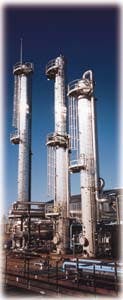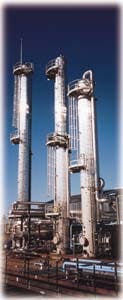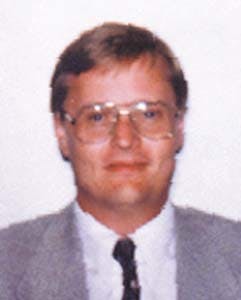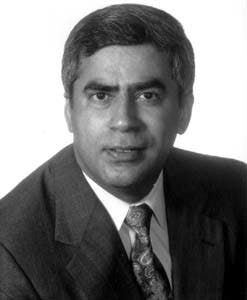C. James Bell
Poco Petroleums Ltd. CalgaryYuv R. Mehra
Advanced Extraction Technologies Inc. Houston
The debutanizer, stripper, and absorber sit adjacent the process skid building at Poco Petroleums Ltd.'s Wolf South plant.Poco Petroleums Ltd., Calgary, has enhanced propane recovery at its Wolf South plant, near Edmonton, without additional dehydration or external solvent make-up.
This was accomplished with a 45-MMscfd addition that uses the Mehra Process unit.
The unit uses the heavier components of the natural-gas feed as the preferred solvent while limiting incremental gas-side pressure drop to about 20 psi. The existing C3+ production is additionally fractionated by the Mehra unit to produce a C5+ gasoline product and a C3/C4 mixed product.
Straight refrigeration
For most natural-gas processing applications outside the U.S. Gulf Coast, NGLs are recovered in straight-refrigeration plants. These plants use propane refrigerant to recover about 30-50% of the propane, and 65-80% of the butanes and heavier hydrocarbons. The NGL-recovery levels depend upon the gas pressure and richness of the gas.Since most of these plants have no access to NGL pipelines, installation of a cryogenic turboexpander process to achieve higher propane recoveries has been historically uneconomical.
Most of the refrigerated lean-oil absorption plants still in operation are considerably larger scale plants (250 MMscfd capacity) and recover about 90% of the contained propane. The smaller old absorption plants have either been taken out of service or, when close to NGL pipelines, have been replaced by cryogenic plants.
There are about 700 refrigeration plants currently in operation in North America. For years, the natural-gas processing industry has been seeking ways to enhance NGL production from straight-refrigeration plants.
Calgary-based Poco Petroleums Ltd. (Poco) has been operating its refrigeration plant since 1993 at the Wolf South facility in central Alberta. Since the original plan to install the refrigeration plant, Poco has been seeking ways to improve value from its natural-gas production for its shareholders.
Mehra Process
Fig. 1 [29,280 bytes] depicts the Mehra Process in which natural-gas feed is dehydrated by injection of ethylene glycol with the mixture then chilled against propane refrigerant to about -20 to -30° F. The condensed ethylene glycol and water mixture is removed from hydrocarbons in a three-phase separator and regenerated for reinjection.The separated chilled hydrocarbons, either combined or separate gas and liquid streams, enter the absorber, a single absorber-stripper column.
The chilled gases flow upward in the absorption section of the column, while the entering liquids flow downward in the stripping section of the column. The stripping section is equipped with a bottom reboiler and in most cases also has a side reboiler.
Through reboiling the column, the rich solvent leaving the bottom of the absorber contains only the allowable amount of light-ends for the NGL product.
For example, if the objective is to produce a C3+ product, then the specified C2-in-C3 specification is achieved by operating the column as a de-ethanizing absorber.
However, if the objective is to produce a C2+ product, then the required C1-in-C2 specification is achieved by operating the column as a demethanizing absorber.
The rich solvent is then fractionated in the regenerator column which operates as a debutanizer. Accordingly and depending upon the recovery objective, the overhead product consists of either the C2C4 or the C3C4 product. The bottoms stream essentially consists of the C5+ hydrocarbons that are present in the natural-gas feed.
As shown in Fig. 1, the hot C5+ gasoline fraction is cooled in the side-reboiler and used as the preferred solvent in the absorber for recovering the desired C2+ or C3+ NGLs from the natural-gas feed. No external solvent is required, therefore, for the Mehra Process unit.
After cooling, excess C5+ fraction, typically containing less than 2 vol % butanes, leaves the unit as the C5+ NGL product.
The cooled lean solvent is mixed with the overhead from the absorber column, and the mixture is chilled against propane refrigerant to presaturate the lean solvent with the undesirable components: methane, if ethane is a desired product component, and ethane, if ethane is not the desired component in the C3+ product.
As a result of the high desirable component recoveries (on the order of 96% ethane in the ethane-recovery mode and 96% propane in the propane-recovery mode), the absorber overhead gases are essentially free of the desired components.
The temperature in the presaturator is no lower than the temperature at the outlet of the feed-gas chiller in order to prevent any water from freezing in the absorber.
The separated, chilled lighter gas from the presaturation separator cools the incoming natural-gas feed before being disposed as the pipeline sales gas. The chilled, presaturated lean solvent is pumped to the top of the absorber for recovering the desired NGLs from the natural-gas feed.
When the natural-gas feed is available at pressures greater than about 450 psig, a dual-pressure absorber column is utilized wherein the absorber section operates at the inlet-gas pressure and the stripping section operates at a pressure less than the critical pressure of the liquid in the bottom reboiler.
Under such operation, the vapors from the overhead of the stripping section are compressed and optionally cooled, if desired, before entering the bottom of the absorber section whereby the two sections operate as a single column.
Enhanced absorption
While there are several similarities between the conventional refrigerated lean-oil processes and the Mehra Process NGL technology, there are many important differences. Some key differences are as follows:Lower-weight solvents
Compared to the conventional refrigerated absorption plants that use 95-140 mole wt lean oils, the Mehra Process technology uses hydrocarbon solvents in the range of 70-90 mole wt.For equivalent equipment size (pumps, columns, piping, exchangers, etc.), lower molecular-weight solvents result in a higher molar flow rate which enhances the absorption capacity and allows a larger gas throughput or conversely achieves higher component recoveries.
With the higher vapor pressure of lighter solvents, the preferred range of 70-90 mole wt achieves a cost-effective balance between capital investment and solvent losses.
Reduced solvent losses
During use of lighter lean oils 95-110 mole wt, the conventional refrigerated absorption processes have relied upon downstream heavy sponge oil absorbers to recover the lighter lean oils.In the Mehra Process technology, however, the warmer overhead gas from the absorber is chilled with the lean solvent in the presaturation step to ensure that the sales gas leaves at the coldest temperature within the unit which significantly reduces the solvent loss.
In most applications, therefore, the required solvent is present in the feed and there is no need for any external solvent make-up.
Heavier components bypassed
Some of the conventional refrigerated lean-oil processes have utilized C 7+ components as the lean oil. In order to maintain a relatively low solvent molecular weight in the preferred range, the heavier components in the inlet gas (primarily C 7+, if present), which are condensed by inlet-gas chilling, may be sent to a front-end stabilizer.When required, the overhead vapors from the stabilizer are compressed and returned to the inlet. The front-end stabilizer is designed to produce a bottoms product that meets the light-end specification of the desired C5+ NGL product.
Absorber-stripper column
In a conventional refrigerated lean-oil plant, the absorber column is followed by a rich-oil demethanizer or rich-oil de-ethanizer (ROD), and the overhead vapors from the ROD flow into the sales-gas pipeline.In the Mehra Process plant, however, the absorption and stripping sections are combined into a single column. This absorber-stripper column can be operated as a demethanizer or as a de-ethanizer.
Solvent presaturator
In the conventional refrigerated lean-oil processes, the lean oil is presaturated with gases leaving the overhead of ROD. These gases are significantly richer in the desired component.By presaturating the lean oil with ethane, if ethane is the desired component, an internal loop of ethane circulating from presaturator to absorber to ROD and back to presaturator limits the ability of lean solvent to absorb ethane in the absorber column.
In the Mehra Process plant, therefore, to improve the efficiency of absorption, the lean solvent is presaturated with the gases leaving the absorber overhead that are essentially free of the desired component.
For instance, if C2+ hydrocarbons are to be recovered, the solvent is presaturated with methane; if C3+ hydrocarbons are to be recovered, the lean solvent is presaturated with ethane.
By achieving high ethane or propane recoveries, the absorber overhead lends itself to the desired presaturation. Also, by removing the initial heat of absorption of lighter components in the lean solvent, the absorption capability of the chilled and presaturated lean solvent is enhanced.
Fig. 1 shows that the presaturated solvent enters the absorber-stripper column at the top.
Upgrading refrigeration plants
A typical refrigeration plant designed to recover a propane-plus product (Fig. 2 [31,929 bytes]) consists of a gas/gas cross-exchanger, gas chiller, a low-temperature separator, and a de-ethanizer column with overhead being compressed and recycled to the inlet. Also shown are three process tie-ins to this existing facility.In Fig. 2, chilled gases from the low-temperature separator are processed in the Mehra Process unit. Because the regenerator column operates like a debutanizer, through tie-in No. 3, the existing C3+ NGL production may be cost-effectively fractionated within the Mehra unit to produce a combined C3-C4 mixed product and a C5+ natural-gasoline product.
Optionally, the existing production may continue to be sold separately or the additional recovered C3-C4 mixed and C5+ NGLs may be combined. The residue gas leaving the solvent presaturation separator flows into the existing cross-exchanger through Tie-in 2 before leaving the facility as the pipeline sales gas.
Wolf South plant
Since Poco's Wolf South plant, 100 miles west of Edmonton, originally came on stream in April 1993, the company has been continually looking at methods to increase the plant's throughput and optimize the value of the product streams.The history of the plant illustrates the declining liquid recoveries as the area developed.
The plant came on stream at 10 MMscfd gas capacity and produced 1,500 b/d of NGL mix. The recovery of 150 bbl/MMscf, corresponding to 54% propane recovery, was achieved with conventional refrigeration (Fig. 3 [27,009 bytes]).
These extremely high liquid recoveries were largely the result of free condensate from one well and would not be sustained over the life of the plant.
With continued growth of the area, the first plant expansion occurred in the fall of 1993. This expansion (Fig. 4 [31,140 bytes]) changed the appearance of the plant as a result of production of PWC-150, Poco's well-fracturing fluid.
The plant's throughput increased to 26 MMscfd and produced 1,800 b/d of NGL mix and 500 b/d of fracturing fluid. Production of fracturing fluid enhances the value of recoverable liquid products.
A significant reduction in liquid recovery, however, from 150 bbl/MMscf to 92 bbl/MMscf, occurred largely because of a change in the amount of inlet condensate as production from the wells began to stabilize. Consequently, propane recovery reduced to 48% as the temperature of the process warmed up with the greater throughput.
By yearend 1994, the inlet composition had stabilized, and the next two expansions occurred in the spring and fall of 1995, each with only one objective: increase gas capacity for minimum capital expense.
This was achieved by adding another compressor, debottlenecking the refrigeration system, and warming the plant from -30° F. to -15° F.
While gas throughput increased to 42 MMscfd, liquid recoveries (mainly propane) were sacrificed. As expected, the propane recovery reduced to 34%.
In spring 1996, the plant throughput reached the target 42 MMscfd with production of 2,200 b/d of NGL mix and 300 b/d of fracturing fluid. These production levels caused an unforeseen operating problem in the de-ethanizer tower.
As the NGLs increased to 2,200 b/d, the de-ethanizer flooded, upsetting the plant and producing off-spec NGL product. Additionally, over a 3-year period, Wolf South plant experienced a dramatic decrease in the recovery capability for propane (Fig. 5 [11,552 bytes]). This caused Poco to re-evaluate the Wolf South plant not only to resolve the de-ethanizer problems but also to look at increasing liquid recoveries.
Process selection
During the search for ways to enhance propane recovery, Poco worked with Advanced Extraction Technologies Inc., Houston, to predict recoveries and establish capital cost estimates for installation of a Mehra Process unit at the Wolf South plant.Table 1 [8,481 bytes] summarizes three options evaluated by Poco to resolve the de-ethanizer operating problems and improve propane recoveries.
Based on this above analysis, Poco determined that the addition of a Mehra Process unit would yield the lowest dollars per incremental barrel of liquids recovered and resolve the de-ethanizer operating problem by rerouting the fractionation-tower overhead liquids away from the de-ethanizer to the stripper column within the Mehra Process unit.
Propane enhancement
To illustrate the propane enhancement, Table 2 [77,977 bytes] and Table 3 [40,040 bytes] show simplified material balances for the existing plant's straight refrigeration process and for the Mehra Process NGL addition.The material balances show that the total plant liquid production will increase from 2,639 b/d to 3,639 b/d. The material balances do not show that the fuel consumption will increase by approximately 0.5 MMscfd with the Mehra Process unit addition.
The recovery of capital investment for this type of project is based on the differential value of propane as a liquid product vs. a gas fuel. For the Wolf South enhancement, increased liquid production of 1,000 b/d offset by about 2 MMscfd shrinkage in sales gas (including fuel) will return the capital expenditure of $ 3.9 million (U.S.) in 2-2.5 years (after paying about 25% of revenues for Alberta provincial royalties).
Implementation
Fig. 6 [32,543 bytes] shows the integration of the Mehra Process unit into the existing infrastructure at the Wolf South plant. Four process tie-ins required to integrate the Mehra Process unit addition are as follows:- Gas from the low-temperature separator is sent to the absorber for processing.
- The chilled sales gas from the presaturated solvent separator flows back to the shell side of the existing gas/gas exchangers.
- The hot liquids from the bottom of the existing de-ethanizer are tied into the new debutanizer column. Fractionating the existing C3+ NGL stream is incrementally inexpensive and provides a higher-value C5+ gasoline product for local market.
- The condensed liquids from the overhead of the fractionation tower are routed away from the existing de-ethanizer and processed in the stripper section of the new absorber column. This change will resolve the de-ethanizer operating problems by unloading up to 700 b/d of liquid from this tower.
Doing so permits attendance to any unexpected operating problems or maintenance needs of the new equipment while continuing to flow the sales gas through the Wolf South facility. These tie-ins are also designed to bring the Mehra unit addition on-line without extensively shutting down the refrigeration plant.
Because of the higher pressure operation (at about 475 psig) of the existing low-temperature separator in the Wolf South plant, it became necessary to use a dual-pressure absorber column within the Mehra Process unit.
To minimize gas-side pressure drop, the absorber section operates at the gas-side pressure and the reboiled-stripper section at a lower pressure. The overhead gases from the stripper section are compressed and enter the bottom of the absorber section (Fig. 6).
Start-up; performance
The construction phase of the project was completed during the last week of April 1997. The utility systems of hot-oil heater and propane refrigeration were commissioned first and began operations on May 1, 1997.As part of the additional precommissioning activities, the natural gas and solvent were circulated through the Mehra Process unit on May 2, 1997. The system operated for 18 hr when a mechanical problem associated with the recycle compressor was identified and subsequently corrected.
During precommissioning of the Mehra unit, the Wolf plant experienced an increase in the overall plant liquid production, confirming that the absorption process was working. And, as expected, initial operation during precommissioning was more or less like a cyclic process. This confirmed the need for tuning the level controls.
Throughout this period, nevertheless the Mehra Process unit operated trouble-free, indicating it could operate unattended.
On May 8, 1997, the addition was commissioned. After 5-6 hr of tuning the level control loops, the process stabilized and was operating under the continuous, steady-state condition.
Based on the first-hand observations of the stability and ease of start-up of the integrated facility, the entire Wolf South complex including the Mehra plant was left to operate unattended during the first night.
The controls were fine-tuned over the next 2 days, and the results showed that the process performance was in line with predicted values. Table 4 [10,402 bytes] presents the gas analyses of initial operation, with the presaturation chiller temperature 4° C. warmer than design and with the solvent circulation rate 10% lower than design.
Since the actual operation closely matches the predicted performance by the Hysim simulator, Poco believes the overall propane recovery will exceed 95% when the operating flows and temperatures are brought in line with the designed conditions.
Poco is now expanding and upgrading its O'Chiese gas plant in central Alberta from 30 MMscfd to 60 MMscfd with the addition of a Mehra Process unit.
BOOK
Why Energy Conservation Fails, by Herbert Inhaber. Published by Quorum Books, Greenwood Publishing Group Inc., P.O. Box 5007, Westport, Conn. 06881. 256 pp., $59.95.Energy efficiency and energy conservation are often thought to be the same, says the author, but they are not. Only when less total energy is consumed by all users, he says, will energy actually be saved. This book addresses the question: "Do government energy conservation programs hinder or help the nation?"
The book includes chapters on how conservation is applied in the electric utility world, whether waste truly exists, the economic aspect of conservation, conservation's relation to Marxism, and past examples of conservation failures.
The Authors
C. James Bell
Poco Petroleums Ltd. Calgary
Yuv R. Mehra is president and chief operating officer of Advanced Extraction Technologies Inc., Houston. He holds 18 patents and an MS in chemical engineering from UCLA. He is a registered professional engineer in Texas and California.
Copyright 1997 Oil & Gas Journal. All Rights Reserved.





